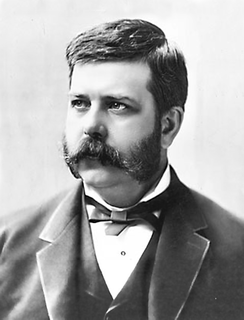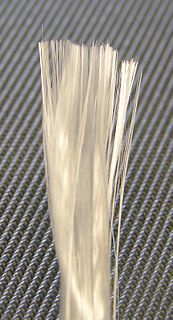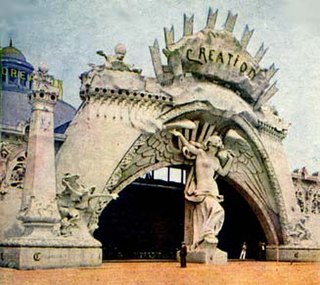
The World's Columbian Exposition was a world's fair held in Chicago in 1893 to celebrate the 400th anniversary of Christopher Columbus' arrival in the New World in 1492. The centerpiece of the Fair, held in Jackson Park, was a large water pool representing the voyage Columbus took to the New World. Chicago had won the right to host the fair over several other cities, including New York City, Washington, D.C., and St. Louis. The exposition was an influential social and cultural event and had a profound effect on architecture, sanitation, the arts, Chicago's self-image, and American industrial optimism.

George Westinghouse Jr. was an American entrepreneur and engineer based in Pennsylvania who created the railway air brake and was a pioneer of the electrical industry, receiving his first patent at the age of 19. Westinghouse saw the potential of using alternating current for electric power distribution in the early 1880s and put all his resources into developing and marketing it. This put Westinghouse's business in direct competition with Thomas Edison, who marketed direct current for electric power distribution. In 1911 Westinghouse received the American Institute of Electrical Engineers's (AIEE) Edison Medal "For meritorious achievement in connection with the development of the alternating current system."

Louis Comfort Tiffany was an American artist and designer who worked in the decorative arts and is best known for his work in stained glass. He is the American artist most associated with the Art Nouveau and Aesthetic movements. He was affiliated with a prestigious collaborative of designers known as the Associated Artists, which included Lockwood de Forest, Candace Wheeler, and Samuel Colman. Tiffany designed stained glass windows and lamps, glass mosaics, blown glass, ceramics, jewelry, enamels, and metalwork. He was the first design director at his family company, Tiffany & Co., founded by his father Charles Lewis Tiffany.

Glass fiber is a material consisting of numerous extremely fine fibers of glass.
Fiberglass, or fibreglass is a common type of fiber-reinforced plastic using glass fiber. The fibers may be randomly arranged, flattened into a sheet, or woven into a fabric. The plastic matrix may be a thermoset polymer matrix—most often based on thermosetting polymers such as epoxy, polyester resin, or vinylester—or a thermoplastic.

The original Ferris Wheel, sometimes also referred to as the Chicago Wheel, was designed and built by George Washington Gale Ferris Jr. as the centerpiece of the Midway at the 1893 World's Columbian Exposition in Chicago, Illinois.
Synthetic fiber or synthetic fibre are fibers made by humans through chemical synthesis, as opposed to natural fibers that are directly derived from living organisms. They are the result of extensive research by scientists to improve upon naturally occurring animal and plant fibers. In general, synthetic fibers are created by extruding fiber-forming materials through spinnerets, forming a fiber. These are called synthetic or artificial fibers. Synthetic fibers are created by a process known as polymerization, which involves combining monomers to make a long chain or polymer. The word polymer comes from a Greek prefix "poly" which means "many" and suffix "mer" which means "single units".. There are two types of polymerization: linear polymerization and cross-linked polymerization.

Owens Corning is an American company that develops and produces insulation, roofing, and fiberglass composites and related materials and products. It is the world‘s largest manufacturer of fiberglass composites. It was formed in 1935 as a partnership between two major American glassworks, Corning Glass Works and Owens-Illinois. The company employs approximately 19,000 people around the world. Owens Corning has been a Fortune 500 company every year since the list was created in 1955. The Pink Panther appears in most of the company’s advertisements.

Glass wool is an insulating material made from fibres of glass arranged using a binder into a texture similar to wool. The process traps many small pockets of air between the glass, and these small air pockets result in high thermal insulation properties. Glass wool is produced in rolls or in slabs, with different thermal and mechanical properties. It may also be produced as a material that can be sprayed or applied in place, on the surface to be insulated. The modern method for producing glass wool was invented by Games Slayter while he was working at the Owens-Illinois Glass Co.. He first applied for a patent for a new process to make glass wool in 1933.

Staff is a kind of artificial stone used for covering and ornamenting temporary buildings.
Micarta is a brand name for composites of linen, canvas, paper, fiberglass, carbon fiber or other fabric in a thermosetting plastic. It was originally used in electrical and decorative applications. Micarta was developed by George Westinghouse at least as early as 1910 using phenolic resins invented by Leo Baekeland. These resins were used to impregnate paper and cotton fabric which were cured under pressure and high temperature to produce laminates. In later years this manufacturing method included the use of fiberglass fabric and other resin types were also used. Today Micarta high-pressure industrial laminates are produced with a wide variety of resins and fibers. The term has been used generically for most resin impregnated fiber compounds. Common uses of modern high-pressure laminates are as electrical insulators, printed circuit board substrates, and knife handles.

Edward Drummond Libbey is regarded as the father of the glass industry in Toledo, Ohio, where he opened the Libbey Glass Company in 1888.

Nippon Sheet Glass Co., Ltd. is a Japanese glass manufacturing company. In 2006 it purchased Pilkington of the United Kingdom. This makes NSG/Pilkington one of the four largest glass companies in the world alongside another Japanese company Asahi Glass, Saint-Gobain, and Guardian Industries.

The Columbian half dollar is a coin issued by the Bureau of the Mint in 1892 and 1893. The first traditional United States commemorative coin, it was issued both to raise funds for the 1893 World's Columbian Exposition and to mark the quadricentennial of the first voyage to the Americas of Christopher Columbus, whose portrait it bears. The Columbian half dollar was the first American coin to depict a historical person.
Fairy lamps were a small, glass candle lamp that originally gained popularity during the 1880s and '90's.

A grass skirt is a costume and garment made with layers of plant fibres such as grasses (Poaceae) and leaves that is fastened at the waistline.
William Edward Sawyer was an American inventor whose contribution was primarily in the field of electric engineering and electric lighting.

Electronic textiles or e-textiles are fabrics that enable digital components such as a battery and a light, and electronics to be embedded in them. "Smart textiles" are fabrics that have been developed with new technologies that provide added value to the wearer. Pailes-Friedman of the Pratt Institute states that "what makes smart fabrics revolutionary is that they have the ability to do many things that traditional fabrics cannot, including communicate, transform, conduct energy and even grow".

Georgie Eva Cayvan was a popular stage actress in the United States in the later part of the nineteenth century.

Indiana is a public artwork by Retta T. Matthews of Arlington, Indiana that was originally displayed in the Indiana State Building at the 1893 Chicago World's Fair. The sculpture is currently located on the fourth floor of the Indiana Statehouse in downtown Indianapolis, Indiana, USA.
















